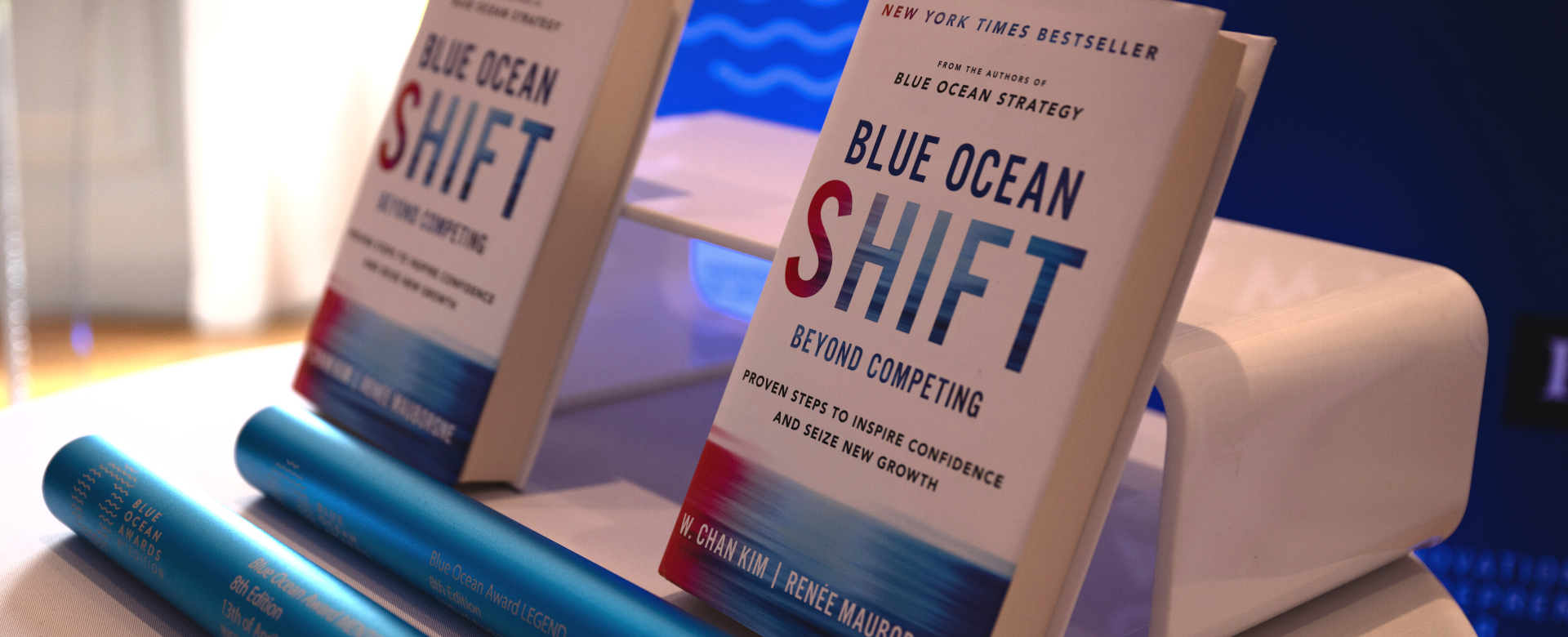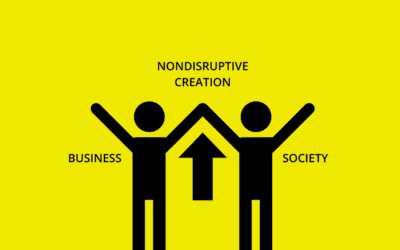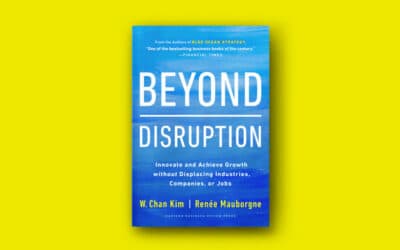For decades, the business and corporate world has been sold on three ideas: One, we should analyze what is, to shape our view of what could be. Two, more than ever today, and even more so in the future, technology innovation is the key to market creation and growth. And three, at the heart of innovation is the lone, smart, and gut-instinct entrepreneur.
Reasonable? Absolutely. Except those are not the right perspectives to lead with to generate innovation and growth. Should you consider them? Yes — and act on them too. But you can think of them as the cart, not the horse. And the horse needs to come first.
We have found that people who generate new markets where none existed before lead with certain perspectives and psychological states that differ in many ways from those long-accepted pillars. While these perspectives are applicable to growth and innovation in general, they are particularly relevant in allowing corporate leaders to expand their opportunity horizon beyond disruption to what we have come to think of as nondisruptive creation.
Nondisruptive creation is when you create a new market without needing to tear down or displace others or your own business. There are no failed companies, lost jobs, or destroyed markets in its wake, opening a path to innovation where business and society can better thrive together. As our research shows, it offers the immense potential to innovate new markets where none existed before. Think of the billion-dollar industry the Square credit card reader unlocked, for example. Microfinance, cell phone accessories, men’s cosmeceuticals, e-sports, life coaching, and the $500 million-dollar pet Halloween costume industry are all prime examples of nondisruptive new markets in action.
People who excel at nondisruptive creation lead with three perspectives:
They flip their mental script.
Let’s begin with a look at the perspective Jack Dorsey led with in creating the $70 billion corporation Square, now renamed Block. The device opened up the nondisruptive new market of credit card readers for individuals and microbusinesses — think farmers’ market vendors, food trucks, and pop-up shops — that had long been unable to accept credit card payments.
Dorsey had seen how his former boss (and eventual cofounder), Jim McKelvey, had lost a sale of handblown glass because of a limited capability to accept credit cards. Because handblown glass tends to be an impulse purchase, McKelvey knew that the sale was lost for good. He was not alone.
As Dorsey and McKelvey looked into it, they saw that people would be thrilled to use credit or debit cards for small transactions, but individuals and most microbusinesses were completely cut off from credit card payment systems, which were dominated by entrenched players with deep pockets who catered to large retailers. The systems were costly, sophisticated, and physically cumbersome, creating nearly insurmountable barriers for individuals and microbusinesses to set themselves up to accept credit card payments.
But Dorsey and McKelvey did not let current conditions shape their view of what should be: that no individual or small business should ever again have to lose a sale because of an inability to accept credit-card payments. The Square Reader, which you simply plug into your mobile phone, is easy to use and easy to carry. Retailers pay only when they use the device, making it attractive for small businesses, pop-up shops, and even individual transactions, such as for babysitters, ice cream trucks, and handymen.
Square’s nondisruptive move created, but it did not destroy. It caused remarkably little if any disruption to existing merchants and their credit card providers. As a result, Square was able to grow quickly into a billion-dollar company without facing any real backlash or fight from established players.
For decades, the business and corporate worlds have been urged to analyze what is in order to shape their view of what could be. In sociological terms, this view directs us to lead with structure and the environment. It effectively says, “This is the chessboard, and these are the pieces. In light of this, how are you going to play best?”
Firms that generate nondisruptive creation lead with agency. Rather than start with the chessboard, they envision what could be and what should be, irrespective of what is. They flip the script, openly questioning and reimagining all the things that those who lead with structure accept as givens. They ask: Why not? What if? That allows them to see what others can’t see, to question what others don’t question, and to reinterpret what is possible and how to achieve it.
They think of tech as means to an end.
Nowadays, it is easy to be seduced by technology. Many companies and startup founders see technology innovation as the path to market creation. They focus on how to engineer and shoehorn the latest technologies into new market offerings they hope will take off. Then they get burned when the market they’re aiming to create doesn’t materialize because people—plain and simple—are not convinced of the value it will deliver to them.
This brings us to the second perspective nondisruptive creators lead with: They don’t confuse the means with the ends. They see technology as a great enabler but realize that value innovation — offering buyers a leap in value — is what ultimately creates a nondisruptive new market.
This may sound counterintuitive, because technology is a critical element of so many market innovations, whether nondisruptive or disruptive. But don’t be fooled. Although new technologies are often major factors in nondisruptive creation, what determines whether a nondisruptive new market takes off and is commercially viable is when these new technologies are driven first and foremost by a step change in value for buyers. Value innovation is what inspires demand behavior, which is real value in use. That applies to blue ocean strategy and disruptive creation as well.
Value innovation can be attained using new technology, as in the nondisruptive case of Square. But it can also be attained by combining existing off-the-shelf technology or even with little or no technology, as in the cases of life coaching, microfinance, or Halloween pet costumes. What is nonnegotiable, however, is that it makes a positive difference in the way we live and work. Nondisruptive creators think value innovation first, and then technology. What is the compelling leap in value you deliver?
Take the classic example of Xerox PARC (the research and development laboratory that was spun off as an independent company in 2002) famous for creating the countless technological innovations, such as the graphical user interface (GUI) on all phones and computers today. And yet they failed to capitalize on any of their inventions. It took the visionary leadership of Microsoft’s Bill Gates and Apple’s Steve Jobs, to turn them into the products we all use every single day.
The company didn’t achieve commercial success or directly create new markets or growth with GUI and many of its other tech innovations. But it did increase the bundle of technologies from which other firms could draw to innovate new markets.
Steve Jobs and Apple were among the first to do just that. When Jobs visited Xerox PARC, he was impressed by the potential of GUI. So he skillfully took Xerox PARC’s technological innovation and linked it to value by creating a simple, intuitive interface that people could understand and feel comfortable using. This allowed Apple to usher in the new market of personal computers and later to create the iOS that powers many of its mobile devices, such as iPod Touch and the iPhone. Eventually other firms followed suit. While the point made through this example here is generally applicable to any pursuit of innovation and growth, it is essential and more relevant to the creation of nondisruptive markets.
They unlock the many, not the few.
Ever since Joseph Schumpeter, the father of innovation, put the entrepreneur on a pedestal, the cult worship of entrepreneurs has been off and running. In Schumpeter’s world, their creativity, daring, and gut instincts are the central drivers of growth, innovation, and the creation of new markets. According to Schumpeter, the entrepreneur is a scarce resource to be cherished.
Which brings us to the third perspective nondisruptive creators lead with: They cherish entrepreneurs or “creative” people but recognize that overemphasizing them leads to underemphasizing the creativity and contributions of everyone else. As a result, a vast expanse of human creativity and ideas risk going overlooked and unappreciated, even though that’s precisely what’s needed to solve brand-new problems outside industry boundaries and create and seize brand new opportunities to realize nondisruptive creation.
Of course, not all people are equally creative. But most are creative enough. To realize market-creating innovation, particularly nondisruptive creation, we need to take a broad view of creativity and innovativeness, embracing the fact that they are ubiquitous and that everybody can contribute to them alongside gifted entrepreneurs, thus maximizing the chances for commercial success.
It takes a network of people with differing perspectives and skills to bring any nondisruptive creation into existence — to cultivate, refine, and collectively figure out what must be learned or unlearned and where the clues are as you draw from here and there and put it all together to realize your new offering. By sharing the right perspectives and discussing how and why they matter, your team can collectively build a culture of creativity needed to generate new markets, growth, and nondisruptive creation.
Ask your team (and yourself):
- Are we leading with structure or with our agency?
- Do we think technology first, or value innovation and offering a magnitude of real value in use?
- And are we looking only to the few for ideas and answers, or are we tapping into the creativity of the many?
These questions and three perspectives can provide a compass for your thinking and efforts in creating a nondisruptive new market. They exert a powerful influence on your conversations, expectations, and behavior, and help establish a culture of creativity that is fundamental to generating market-creating innovation.
This is a lightly edited excerpt from Beyond Disruption: Innovate and Achieve Growth Without Displacing Industries, Companies, or Jobs (Harvard Business Review Press).
Originally published in Harvard Business Review.

















